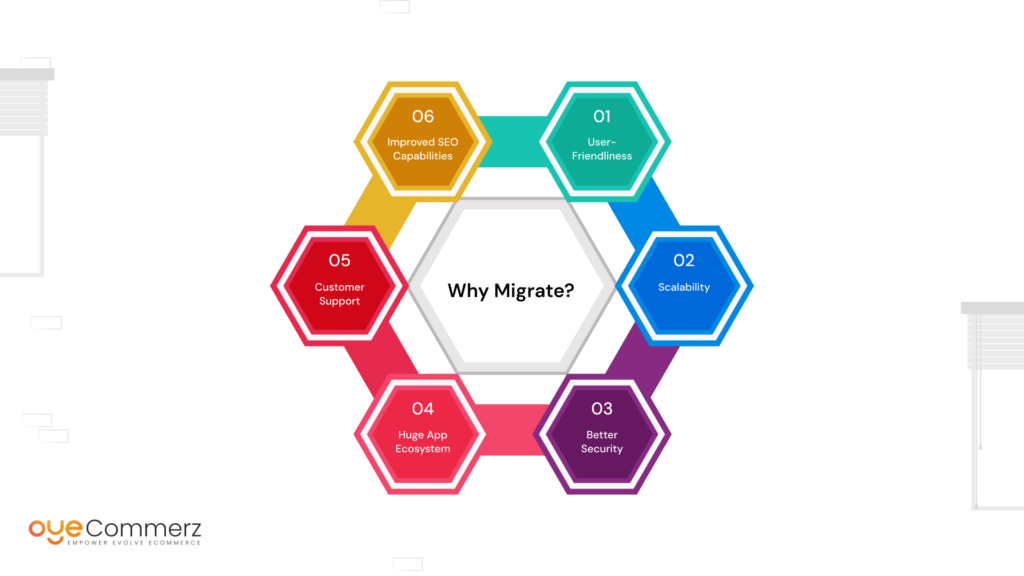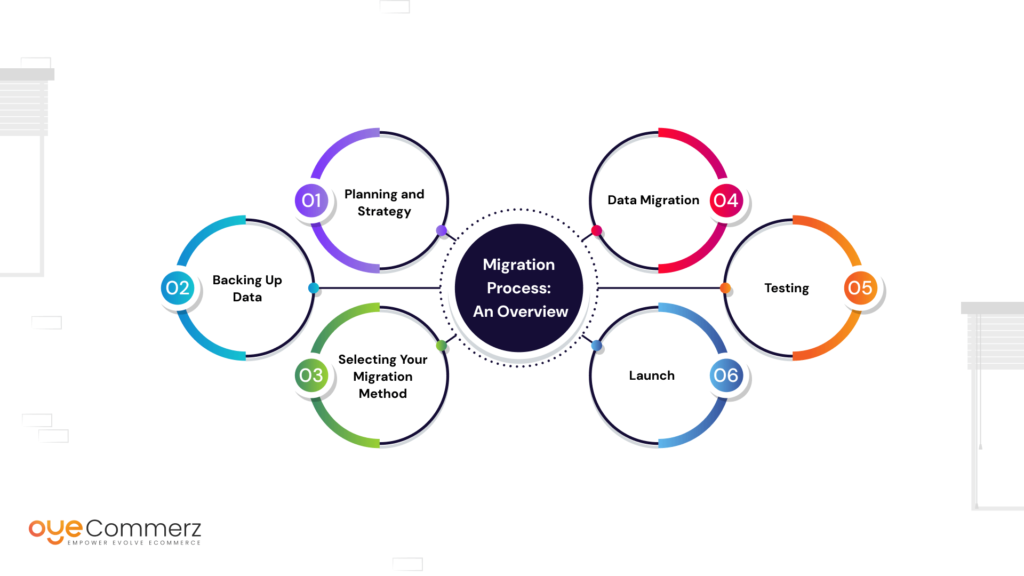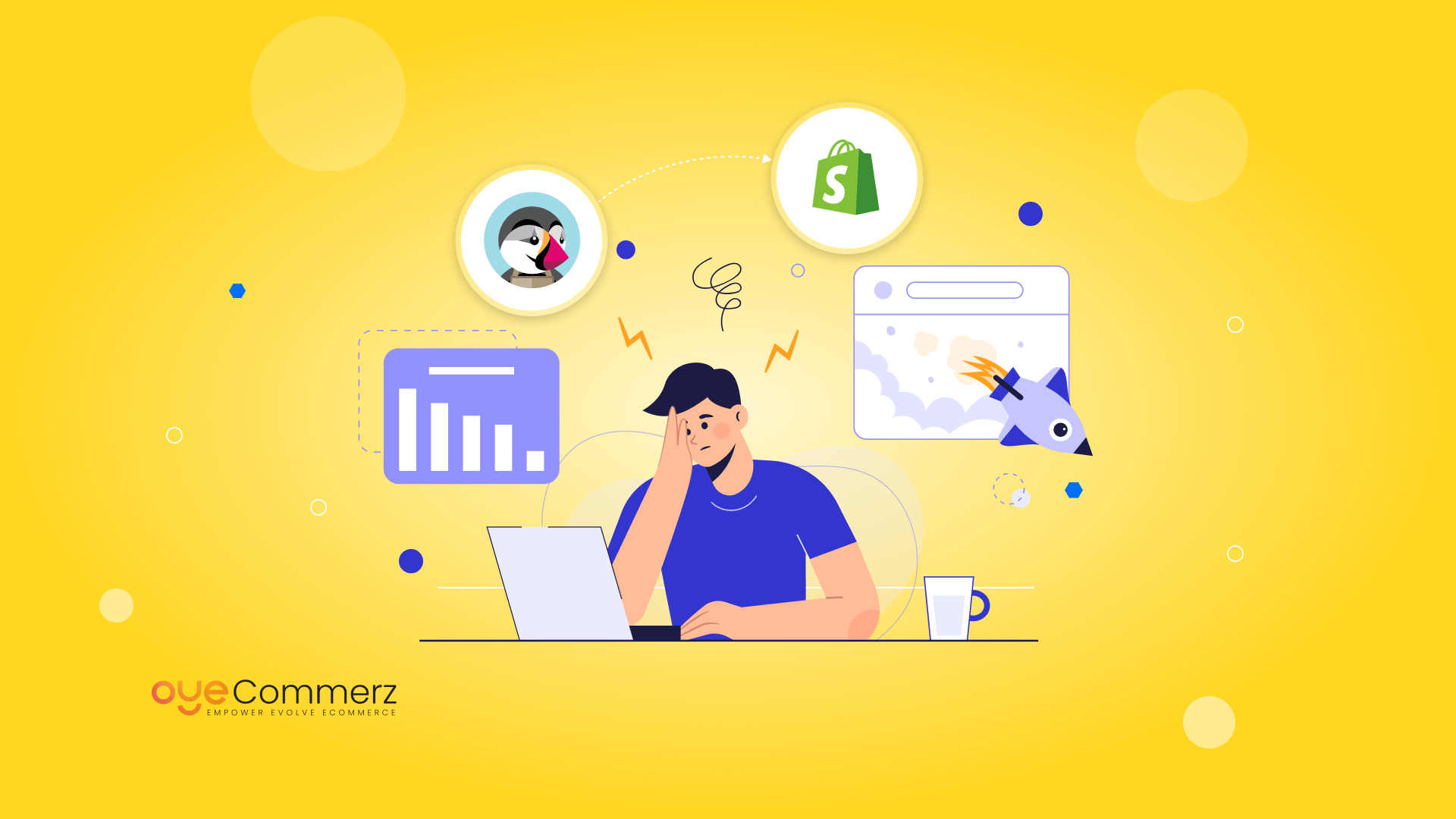Migrating from PrestaShop to Shopify is an exciting step toward leveling up your eCommerce game. Shopify’s user-friendly platform and robust features make it a popular choice for businesses aiming to scale. However, migration isn’t just about moving data it’s a process that requires careful planning to avoid hiccups that could disrupt your store’s performance.
Mistakes like data loss, broken URLs, or poorly mapped designs can cost you customers and sales. That’s why it’s essential to get it right the first time. In this blog, we’ll highlight common mistakes to avoid during a PrestaShop to Shopify migration, helping you ensure a seamless transition while preserving your store’s functionality and customer experience.
Table of Contents
ToggleWhy Should Migrate from PrestaShop to Shopify?

There are multiple relevant reasons online retailers would shift from PrestaShop to Shopify:
User-Friendliness
Shopify is designed for users who have technical knowledge at different levels. It will make it easy for merchants to run their stores without having to dig deep into any codes.
Scalability
At different capacities of growth, Shopify can help you scale out quite easily. It ensures that traffic and sales will not jam its performance when your business scales out.
Better Security
Shopify’s security parameters will include SSL certificates and PCI compliance, so you won’t have to worry about protecting the data as that will be taken care of by Shopify.
Huge App Ecosystem
Shopify has thousands of possible integrations that can make the functionalities of marketing tools to the inventory management system in your store.
Customer Support
The migrations process, as well as after it, will be very worthwhile since Shopify is available 24/7 for its customer support.
Improved SEO Capabilities
Shopify is optimized for all the search engines, which will in turn increase the chances of visibility and greater conversion rates.
However, these benefits come with a toll as switching from PrestaShop to Shopify is not just a matter of clicking a button; it demands careful planning and execution because common mistakes can put your e-commerce ventures at risk.
Understanding the Migration Process: An Overview

The migration from PrestaShop to Shopify requires detailed work based on several quite significant steps. So, here is the general overview of the migration process:
Planning and Strategy
Set up your target for migration, create a timeline, and determine your resources to set yourself up for a successful transition.
Backing Up Data
Before making the changes, have a backup of your PrestaShop data so that possible data loss can be minimized during migration.
Selecting Your Migration Method
You can either choose to manually migrate, use a migration tool, or hire the services of professional service providers. Each one has pros and cons, which would be dictated by your technical know-how and budget.
Data Migration
After importing the data, you will need to design your new store to meet your brand standards and also optimize for user experience.
Testing
The testing process happens to be one of the major requirements before launching your new Shopify store, and it ensures everything works as anticipated.
Launch
You can finally launch your new Shopify store, but continuous monitoring is required to catch potential issues early on.
All these steps will, therefore, help you prepare better so that you can face what happens in terms of migration with fewer possibilities of committing common mistakes during this process.
Related Read: A Step-by-Step Guide to Migrating from PrestaShop to Shopify
Mistakes to Avoid During PrestaShop to Shopify Migration

1. Inadequate Planning
Most business leaders make the grave mistake of jumping into migration without a clear plan. A good plan should have timelines, budgets, and specific goals. Without proper planning, you risk a lag in schedule, over-spending, and not achieving desired outcomes. Take the time to map out every step of the process, and ensure your team is involved in this planning phase so that everyone is on the same page.
2. Data Loss Risks
Data is your lifeblood and losing while migrating may lead to extreme consequences. Whether it’s product information, customer details, or order history, loss of data may pave the way to a decline in customer trust and eventually revenue loss. Always create a complete backup of your PrestaShop store before you begin the migration. Migration through the use of automated migration tools should be considered so that some of the data is not lost tools are programmed to migrate data from the original system in a secure way.
3. Ignoring SEO Implications
Mistakes Made During Migration It often occurs that one forgets that search engine optimization is often impacted as well. If the URLs have been changed, or the metadata was not migrated, you could experience a huge loss in organic traffic. This risk can be avoided if you have 301 redirects from your older PrestaShop URLs to the new Shopify URLs. Make sure also to confirm your on-page SEO factors, such as title tags and meta descriptions, to keep your site’s search visibility.
4. Overlooking Custom Features
PrestaShop offers a lot of functionalities that do not have direct equivalents in Shopify. Ignoring these custom features while moving over will lead to functionality issues or losing out on important functionalities when it comes to the migration process. You should audit your site before migrating it and find out what custom functionality that exists on your site. Find out in which apps in Shopify mirror those or find out a custom development that will fill in those gaps.
5. Underestimating Time and Resources
Shop may also be time-consuming especially if you have a big catalogue or complicated website design. Underestimating time miserably can make you rush into decisions that are not well thought out and hence some parts of the migrating process go uncomplete. Prepare enough time and resources for migration as well as being prepared for unexpected issues that might crop up during this stage. It’s mainly wise to have an input ready; thus, one should have all needed help ready.
6. Neglecting User Experience
Make sure your new Shopify store is enjoyable and easy for customers to shop from. That means optimizing site navigation, making it responsive on mobile, and keeping a clean and nice-looking design. It should be put into a position where the entire user experience has been tested completely before going live with your site to ensure everything works as smoothly as possible.
7. Failure to Test Your New Store
Once your data has been migrated into the system and your new store is set up, now’s the time to start the testing process before you go live. Failure to do so may result in broken links, processing problems with payment, and other technical issues that will annoy your customers and deter sales. Prepare your testing checklist for all aspects of your store- product pages, checkout processes, payment gateways, among others. Collect feedback from the team along with a few trusted customers about any problems.
8. Not Using Shopify Apps
The Shopify platform is very rich in the app ecosystem, enhancing the functionality of a store. Not using these apps would be similar to going through an opportunity to streamline operations or even engage customers. Be it marketing automation tools, inventory management solutions, or something else, the potential value-added applications to your store can be discovered. Assess your business requirements and then choose what applications will suit those needs best.
9. Lack of Training
Transitioning to a new platform is challenging for your team. You’ll have low productivity and high error rates in case they don’t learn to use Shopify the correct way. Teach them how to access the Shopify interface, manage products and orders, and solve common mistakes. You can either provide training sessions or resources that make it easy for them to learn.
10. Missing Analytics Setup
Analytics is the only way you can understand your store’s performance and make your business decisions based on information you can trust. Missing analytics configuration during migration leaves you with no eyes after deploying your new Shopify store. So ensure you configure Google Analytics as well as other tracking tools before going live. This will let you follow how much traffic is coming to your site, what users are doing on the site, and what’s their conversion rate. All this information will allow you to make data-driven decisions in the future.
Tips to Remember
Regular Backups
Even after the migration process, regularly back up your Shopify store data so that no data will be lost in the future.
SEO Performance
After launching your new website, track for any kind of traffic drop in the SEO metrics. Make necessary changes accordingly.
Keep Updated with Your Customers
Inform your customers about the migration, and let them know how much you value their feedback about their experience while surfing on the new site.
Keep Updated with Shopify Features
Shopify, always introducing its version of improvements and features, is constantly updating the platform it offers. Learn about its updates so you can have the most of all that Shopify has in store for you.
Migrate from PrestaShop to Shopify with OyeCommerz!
At OyeCommerz, we understand the challenges of this transition. Our expert team can guide you through the process, helping you avoid common mistakes that can lead to data loss and decreased traffic. With our tailored solutions, you’ll ensure a seamless migration while optimizing your store for maximum performance. Don’t leave your success to chance
Contact us now for a free consultation and start your migration journey with confidence!
Contact to Migrate your Site to Shopify Now
Conclusion
Migrating PrestaShop to Shopify gives your e-commerce site the tools and capability to do very well in the competitive e-commerce landscape. But there’s a need for careful execution of the process to avoid making some common mistakes that underrun success. By understanding the migration process, planning well, and keeping to minute details, you ensure a smooth transition that puts your store on good footing.
Thus, consider the stages of creating a Shopify store keeping in mind data protection, SEO considerations, and the user experience. Equipped with the right knowledge and prep, your new Shopify store can become a professional base to carry on a successful business. There is a chance to make a difference by taking your e-commerce strategy up and getting your online store booming.



